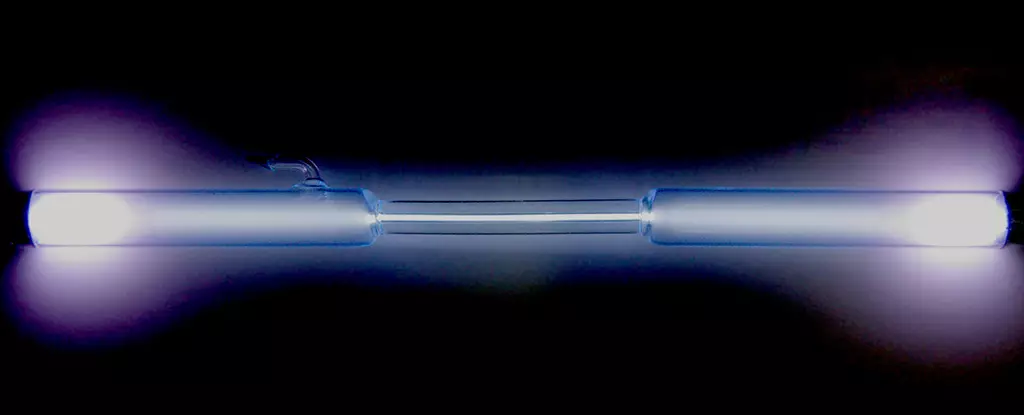When considering treatments for complex neurological disorders like Alzheimer’s disease, one might not initially think of xenon—an inert noble gas—as a viable option. Historically viewed as a mere curiosity of atomic chemistry, xenon’s unique properties are now capturing the attention of researchers as a possible therapeutic agent. Traditionally utilized as an anesthetic since the mid-20th century, recent studies are revealing xenon’s potential benefits for conditions such as brain injuries and psychiatric disorders. This has laid the groundwork for investigating whether it can play a role in managing Alzheimer’s, a disease characterized by debilitating cognitive decline.
Alzheimer’s disease is a multifaceted ailment primarily affecting memory, thought processes, and behavior. The hallmark features of Alzheimer’s pathology include the accumulation of amyloid-beta plaques and tau tangles, which disrupt normal brain function. Scientific inquiry suggests these abnormal protein aggregates damage synapses—the essential connections between neurons—and exacerbate inflammatory responses within the brain. Unlike typical inflammation, which resolves after an injury heals, chronic inflammation in Alzheimer’s patients often leads to further neurodegeneration, compounding the cognitive dysfunction associated with this devastating disease.
Unfortunately, the precise etiology of Alzheimer’s remains elusive, but theories commonly attribute its onset to a cascade of cellular dysfunction initiated by amyloid accumulation. Historically, targeting these protein aggregates has been the primary therapeutic strategy, exemplified by treatments that moderately slow cognitive decline by addressing amyloid levels. However, this approach has led to critical discussions about its sufficiency in halting disease progression, especially given the complex interplay of various cellular actors within the brain.
Microglia, the brain’s resident immune cells, act as the first line of defense against neurotoxic agents and cellular debris. They are integral to maintaining neurological health but can become double-edged swords. Under pathological conditions, such as Alzheimer’s, microglial activation escalates chronic inflammation, undermining neuronal health and facilitating disease progression. Layers of complexity unfold as these cells transition between states; an activated microglial state can either protect or exacerbate neurological damage, depending on the surrounding environment.
Recent research highlights the necessity of understanding the delicate balance of microglial functions, especially in their interactions with amyloid and tau. If xenon can modulate these immune responses, as preliminary studies suggest, it opens up a new frontier in therapeutic intervention.
The recent investigation conducted by researchers at Washington University and Brigham and Women’s Hospital has unveiled promising results regarding xenon’s effects on Alzheimer’s-like conditions in mice. Inhalation of xenon appears to catalyze a transformation among microglia, shifting them from a state associated with Alzheimer’s pathology to one focused on clearing amyloid deposits while reducing inflammation. This ability to alter the microglial state could potentially mitigate the overall neurotoxicity associated with Alzheimer’s.
In the experimental setup, the mice subjected to xenon inhalation exhibited a notable decrease in the size and quantity of amyloid plaques. Furthermore, there was evidence suggesting that xenon may reduce the typical brain shrinkage characterized by Alzheimer’s, offering hope that this gas could bolster neuronal connections—the very essence of thought and memory.
Although these findings are groundbreaking, it is crucial to approach them with a balanced perspective. The transition from promising preclinical results to effective human therapies necessitates thorough clinical trials, which are slated to begin shortly. Initial testing will focus on safety, feasibility, and efficacy in healthy volunteers, laying the groundwork for further investigation within Alzheimer’s populations.
If subsequent studies confirm that xenon can effectively reset the brain’s immune response without directly targeting amyloid, this could present a revolutionary shift in Alzheimer’s treatment paradigms. Rather than being merely an antagonist to amyloid, xenon could position itself as a modulator of the brain’s inflammatory landscape, addressing multiple facets of the disease simultaneously.
Xenon’s potential contribution to Alzheimer’s treatment exemplifies the importance of thinking outside conventional medical frameworks. While the concept of using an inert gas to alter the pathophysiology of a complex neurodegenerative disorder may initially seem outlandish, this research underscores the compelling need for innovative, multifaceted approaches to tackle diseases that have long perplexed both scientists and clinicians alike. As we continue to uncover the nuances of neurobiology, xenon may indeed emerge as a revolutionary ally in the fight against one of humanity’s most challenging health crises.

